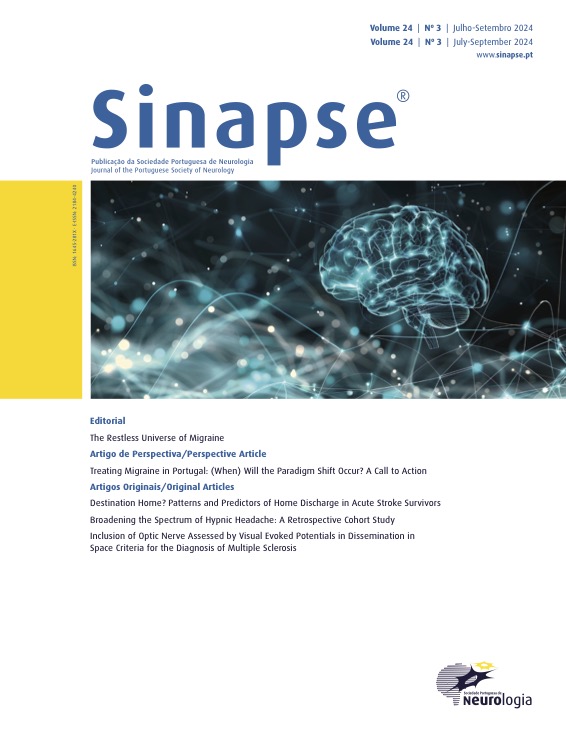Ampliando o Espectro da Cefaleia Hípnica: Um Estudo de Coorte Retrospetivo
DOI:
https://doi.org/10.46531/sinapse/AO/240004/2024Palavras-chave:
Distúrbios da Cefaleia Primários/tratamento farmacológico, SonoResumo
Introdução: A cefaleia hípnica é uma entidade rara que requer crises estritamente relacionados ao sono. Contudo, existem doentes com cefaleias noturnas recorrentes que apresentam ocasionais crises em vigília e que são excluídos desse diagnóstico. O nosso objetivo foi comparar esses dois grupos de doentes e compreender se as suas diferenças justificam um diagnóstico distinto.Métodos: Trata-se de um estudo de coorte retrospetivo, comparativo, entre doentes com cefaleia recorrente predominantemente noturna (≥80% das crises) (PNRH) e cefaleia hípnica (HH) seguidos numa clínica terciária de cefaleias.
Resultados: Foram incluídos 31 doentes (83,9% mulheres), dos quais 13 com PNRH e 18 HH (13 casos com HH provável e 5 HH definitiva). Não houve diferenças significativas entre os grupos quer na demografia quer nas características da dor e resposta ao tratamento. Ambos tinham uma frequência elevada (71%) de crises prévias de enxaqueca e 51,7% preenchiam os critérios para uso excessivo de medicamentos.
Conclusão: Estes resultados sugerem que existe uma sobreposição entre a cefaleia hípnica e a cefaleia recorrente predominantemente noturna. Ambas podem evoluir a partir de enxaqueca. Embora a sua fisiopatologia permaneça desconhecida, a cefaleia noturna recorrente pode ser outra forma provável de cefaleia hípnica.
Downloads
Referências
Ferini-Strambi L, Galbiati A, Combi R. Sleep disorder-related headaches. Neurol Sci. 2019;40:107-113. doi: 10.1007/s10072-019-03837-z.
Raskin NH. The Hypnic Headache Syndrome. Headache.1988;28:534–6.
Headache Classification Subcommittee of the International Headache Society. The International Classification of Headache Disorders: 2nd edition. Cephalalgia. 2004;24 Suppl 1:9-160. doi: 10.1111/j.1468-2982.2003.00824.x.
Headache Classification Committee of the International Headache Society (IHS) The International Classification of Headache Disorders, 3rd edition. Cephalalgia. 2018;38:1-211. doi: 10.1177/0333102417738202.
Eliasson JH, Scher AI, Buse DC, Tietjen G, Lipton RB, Launer LJ, et al. The prevalence of hypnic headache in Iceland. Cephalalgia. 2020;40:863-5. doi: 10.1177/0333102420911209.
Holle D, Naegel S, Obermann M. Hypnic headache. Cephalalgia. 2013;33:1349-57. doi: 10.1177/0333102413495967.
Gori S, Lucchesi C, Baldacci F, Bonuccelli U. Preferential occurrence of attacks during night sleep and/or upon
awakening negatively affects migraine clinical presentation. Funct Neurol. 2015;30:119-23. doi: 10.11138/fneur/2015.30.2.
Holle D, Naegel S, Obermann M. Pathophysiology of hypnic headache. Cephalalgia. 2014;34:806-12. doi: 10.1177/0333102414535996.
Straube A, Andreou A. Primary headaches during lifespan. J Headache Pain. 2019;20:35. doi: 10.1186/s10194-019-0985-0. Erratum in: J Headache Pain. 2019;20:71. doi: 10.1186/s10194-019-1025-9.
Soriani S, Fiumana E, Manfredini R, Boari B, Battistella PA, Canetta E, et al. Circadian and seasonal variation of migraine attacks in children. Headache. 2006;46:1571-4. doi: 10.1111/j.1526-4610.2006.00613.x.
Kelman L. Pain Characteristics of the Acute Migraine Attack. Headache. 2006;46:942–53. doi: 10.1111/j.1526-4610.2006.00443.x.
Downloads
Publicado
Como Citar
Edição
Secção
Licença
Direitos de Autor (c) 2024 Filipa Dourado Sotero, Miguel Leal Rato, Isabel Pavão Martins (Autor)

Este trabalho encontra-se publicado com a Creative Commons Atribuição-NãoComercial 4.0.








